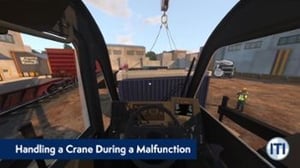When people hear “Virtual Reality,” they usually think of VR Games like Beat Saber or Vader Immortal, and it’s not hard to understand why: over the last decade, VR grew from a quaint little startup market to a ten-figure industry on the backs of these popular and immersive experiences. What was once thought of as a gimmicky peripheral, soon to go the way of similar devices like the Virtual Boy or the Power Glove, has instead blossomed into an entire ecosystem in the span of a few short years, with several major VR groups aiming to capture a market that’s projected to double to more than ten billion by 2024.
But amidst all the excitement about playing in virtual reality, it’s easy to forget that the same qualities that make VR Games enjoyable make VR Education engaging and retentive; when people are actively participating in a hands-on learning experience, they retain more information, and are more likely to be able to apply that information in the field. As any seasoned operator can tell you, however, cranes are expensive. On top of the steep price tag that comes with ownership, they require space to practice, fuel and maintenance, and of course, an instructor to supervise and train students. Where live crane operation is inaccessible, unfeasible, or simply in short supply and high demand, the ITI VR Crane Sim helps deliver lifelike crane training and load handling exercises for crane operators no matter where they are, at a significantly lower price than live training. Follow along with a crane operator as they demonstrate just a handful of the skills that the VR Crane Sim can help sharpen:
1. Navigating tight spaces with a load
The VR Crane Sim offers a multitude of corridor scenarios that operate similarly to the NCCCO’s Z-Corridor: A user is tasked with lifting a barrel off the ground while keeping an attached chain in contact with the path, navigating through the course, and setting the load down in a target circle, all within a time limit. Corridors range from simple lines and arcs to complex, twisting routes that require cautious handling of the test weight.
2. Learning the OSHA standard hand signals
All crane operators are required to adhere to the OSHA standard hand signals while operating a crane. One way to teach users these signals, is to have them navigate a load through a virtual maze with a fully voiced and animated signalperson. Administrators can toggle between hand signals, voice signals, or both, to train and test as desired.
3. Performing blind lifts
Operators will not always have visual contact with the load; sometimes, it must be lifted or placed outside of the operator’s line of sight. Several lift scenarios that the ITI VR Crane Sim offers involve picking or placing loads while relying solely on the signalperson’s instructions, requiring great precision in order not to clip the sides of an opening or contact an unseen obstruction.
4. Settling the load out of a death spiral
One of the most important skills an operator can learn is catching a wildly swinging load, especially when the load is swinging in a circular motion, colloquially referred to as a “death spiral.” Novice operators have an inclination to swing away from the moving load, inadvertently exacerbating the problem in the process. Here, the sim teaches operators to swing in the direction of the load’s movement as the load passes under the boom tip:
5. Performing critical lifts
In certain cases, operators will need to perform lifts that require careful attention to one or more factors: heavy lifts, delicate or dangerous loads, or proximity to power lines can all introduce a need for careful and precise load handling, beyond even what is normally required. With the VR Crane Sim, operators can practice on these sensitive tasks without fear of harming anyone or anything.
6. Setting up a crane for a lift
Though the crane sim focuses primarily on building operational skills, it’s also important to know how to determine whether or not a crane can actually make a lift. Select scenarios allow operators to fill out a crane’s deduction checklist to ensure that, from pick to set-down, a crane has the capacity required to lift a load.
7. Handling a crane during a malfunction
One learning opportunity the crane sim offers that no other crane can replicate is the ability to recreate a crisis in a safe and controlled environment. Mechanical failures, inclement weather, high winds and more can all be toggled by an administrator during a scenario to give operators the chance to learn how to react in an emergency with zero risk to equipment, personnel, or loads.
All this and much, much more can be found in the ITI VR Crane Sim, available for a fraction of the cost of live crane operation. If any of these skills sound like something you or your employees would be interested in learning, the next step is up to you! You can use the free ITI VR Crane Simulator Build & Price Tool to explore different options and build a simulator that is perfect for your team.
Alternatively, you can skip all that and request a demo of ITI VR today!
If you just want to learn more about ITI VR, well, that is encouraged as well! Visit www.iti.com/vr for additional information on specific crane types, customer success stories, VR resources, news, and more.





COMMENTS